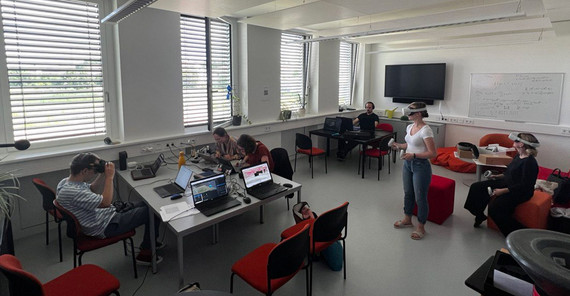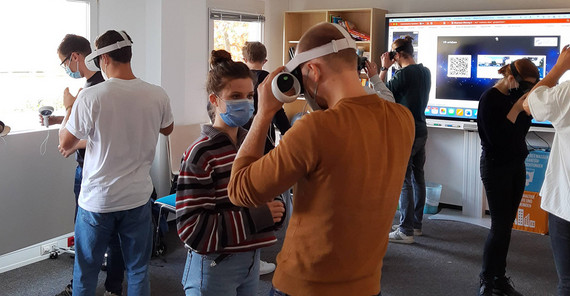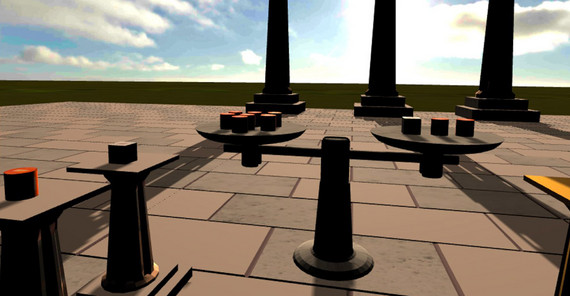The geography didactics expert has been researching the possible application of virtual reality in geography lessons for several years now and is also in close contact with other subject didactics departments. “There are now many initiatives at the university that are dealing with this. A real focus is emerging,” observes Nina Brendel. “It was time to use these resources, pool expertise, and describe individual areas of development.” No sooner said than done. Inspired by University Vice President Britta van Kempen, Nina Brendel designed the “VReiraum” project, with which she successfully competed in the “Freiraum” competition organized by the Foundation for Innovation in Higher Education. The name says it all: One year of time and resources to experiment with VR and AR technology, try out new things and see how these media can be efficiently integrated into university teaching. Not only in geography and computer science, but also in mathematics and music, history and chemistry. The students were involved right from the start.
“After all, it wasn’t just a research project, but above all a teaching project,” explains coordinator Lisann Prote. Five pillars carry the roof under which the different subjects were able to come together, exchange and network across disciplines. Makerspace is what the initiators called the common space, the first pillar of which was formed by two very real VR labs. In the two laboratories, the students found everything they needed to “build” virtual learning environments: VR glasses, 360-degree cameras, telescopic bars, and a VR-capable laptop. Any technical equipment they lacked could be borrowed from the individual subjects. An advantage of interdisciplinary collaboration.
The technology is already part of our lives
The second pillar, which Prof. Brendel considers indispensable for success, is a well thought out support structure. It guaranteed that the students could access the research expertise and advice of all lecturers and were therefore able to get to know perspectives on VR and AR from outside their own field. The virtual and augmented learning worlds that they developed under professional guidance were then tested in school practice. “We had previously discussed with the teachers what was currently being covered in class and tailored our offering accordingly,” Brendel reports. What knowledge and experience do the students already have? What can we build on? What content should be taught, what learning objectives should be achieved? All of this needs to be clarified in advance, as with any other lesson planning, emphasizes the didact. “The classes in which we tried this out were curious and interested,” Prof. Brendel reports.
This technology is already part of the lives of children and adolescents. She is certain that the culture of digitality will change the way we learn and create. “We need to prepare ourselves for this.” It was therefore all the more important that the student teachers involved in the project received immediate feedback on whether and how their VR environment “worked” and led to learning success.
The entire process was scientifically monitored to be able to develop a first draft of a competence model on VR and AR for teacher training at the university. The “VReiraum” project also produced interdisciplinary teaching materials, which are now freely available to all lecturers as Open Educational Resources (OER).
Lisann Prote, who coordinates the project, describes the networking of the lecturers as the third pillar. “In the course of the project, we realized that the responsibility for networking initially had to rest more with the lecturers. They initiated mutual visits to the seminars or organized short input contributions from lecturers outside the subject area for the students. For example, a chemistry didactics specialist explained a tool called BlippAR, which is used in chemistry didactics, in the history seminar.” Just one example of interdisciplinarity in use in the “VReiraum”. Tutorials, instructions, and podcasts created in the individual subjects now complement the makerspace.
Discussing chances and risks
A fourth pillar is the input of external experts. Prof. Pablo Dornhege from the Berlin University of Applied Sciences, for example, talked about the problem that usually only one person is in a virtual space and the others are watching without interacting. As a solution, he presented forms of joint learning in hybrid-real spaces that have been tested at his university. The lecture by Jonas Hansen, Professor of Design and Media Technology at Burg Giebichenstein University of Art and Design in Halle, focused on the design of immersive experiential spaces. Prof. Raphael Zender, computer science didactics expert at Humboldt University of Berlin, addressed the fact that virtual reality in school lessons not only creates great opportunities but also risks. Thanks to such guest contributions, “VReiraum” indeed provided the freedom for academic discussions and an interdisciplinary exchange of ideas.
Finally, a networking and documentation platform - the fifth pillar of the project - was created to collect all the findings and results and secure them for the future. It also included an ideas workshop in which virtual learning environments were presented and tested. For example, the VR classroom, in which student teachers learn to act in concrete teaching situations. Geography didactics invited students to a 360-degree excursion to the German-Polish border region in Frankfurt/Oder. Music didactics showed how its students conduct a virtual orchestra, and mathematics didactics used Cubeling VR to virtually reconstruct cube figures ...
Think tank planned
What will happen next? Will the “VReiraum” be closed again after one year of project funding? Not at all, says Prof. Brendel. “We have achieved a high level of visibility within the university. We are in contact with the Center for Information Technology and Media Management to expand the infrastructure. We are also in agreement with the Chief Information Officer and the Vice President for Teaching and Learning about using the experience in order to create a larger kind of makerspace for the entire university,” the initiator reports. And, of course, the exchange between the subjects will continue. “We have learned so much from each other,” says the geography didactics expert. The expert input is also paving the way for new collaborations, for example with Humboldt University or Babelsberg Film University. Last but not least, the Center for Teacher Training and Educational Research wants to set up a VR think tank financed by scholarships.
Project Management and Coordination
Prof. Dr. Nina Brendel began her work at the University of Potsdam as a Junior Professor in 2017. She has been Professor for Geography Education since 2021.
Lisann Prote has been a research assistant in geography didactics at the Institute of Environmental Science and Geography of the University of Potsdam since 2022 and coordinates the “VReiraum” project.
The Project
VReiraum – Development of An Interdisciplinary VR/ AR Makerspace for future Teachers at the University of Potsdam
Funding: Foundation for Innovation in Higher Education
Duration: 8/2022–11/2023
https://www.uni-potsdam.de/de/vreiraum
Spaces for Innovative Teaching Projects
The Stiftung Innovation in der Hochschullehre (Foundation for Innovation in Higher Education) funded a total of eight innovative teaching projects at universities in Brandenburg with approximately 1.46 million euros as part of its “Freiraum 2022” funding program. “We need long-term strategies for forward-oriented teaching and experimental leeway for the development of fresh ideas,” says Dr. Manja Schüle, Minister of Science of the Federal State of Brandenburg. “The eight Brandenburg projects support the transformation towards new, inclusive, even more participatory forms of teaching, learning, and knowledge transfer. Progressive teaching ‘Made in Brandenburg’ ensures quality higher education and the future of the state.”
Website of the foundation: https://stiftung-hochschullehre.de
This text was published in the university magazine Portal Wissen - Eins 2024 „Bildung:digital“ (PDF).



